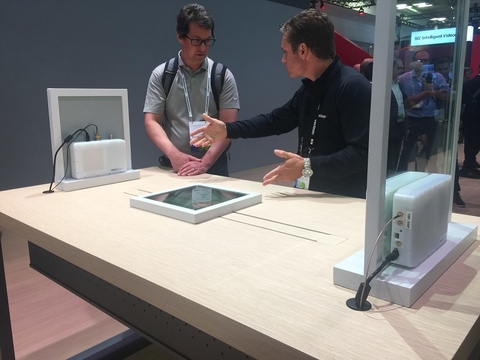SAN FRANCISCO—Verizon here at the Mobile World Congress Americas trade show said it may have solved one of the key problems dogging the 5G space: how to transmit 28 GHz signals through windows that block UV rays.
While this might sound like a minor inconvenience in the multibillion-dollar buildup to 5G, it’s actually not. Getting millimeter-wave signals to travel anywhere is difficult, but it’s really hard to get those signals to travel through windows that are coated with material that reflects UV light (and most new homes and offices require this kind of coating in order to lower cooling costs).
This situation poses a big problem for Verizon, because the carrier wants to be able to use 5G to deliver superfast internet to homes and businesses instead of fiber. If those signals can’t get past windows, users would probably have to have Verizon technicians install antennas on the outside of their home or office. This kind of specialized installation would be expensive, to say the least, and would therefore significantly cut into any savings Verizon might score by using 5G instead of fiber.
So how exactly did Verizon (and its partner Nokia Bell Labs) solve this particular problem?
As Edward Jack, lab manager at a Verizon Innovation Center, explained to me, the carrier employed a solution that’s both high-tech and simple at the same time.
Basically, Verizon invented a two-part 5G modem: One part sits outside a user’s window, and the other part sits right on the other side of the window. The two parts are connected by magnets or some other method (in Verizon’s demo they were taped to the window) in a way that ensures the two halves line up exactly.
The antenna, receiver and transmitter are on the outside of the window, while the power, display and connection ports are on the inside. The two halves communicate through the half-inch of glass wirelessly, but Verizon’s Jack said that the connection technology used there was the “secret sauce” of the design and he wouldn’t tell me exactly how it worked.
Suffice to say, though, that the operator’s prototype modem functioned as advertised; Verizon was able to transmit a 28 GHz 5G signal from a transmitter to a receiver on the outside of the window, and then through the window to the internet port on the inside. Jack said the demo supported speeds up to 1.2 Gbps, but he noted that Verizon’s eventual 5G service would likely support much faster speeds than that.

So, why is this new solution important?
Verizon is hoping to use its 5G Technology Forum network specifications, developed with Cisco, Ericsson, Intel, LG, Nokia, Qualcomm and Samsung, for a fixed wireless service in the 28 and 39 GHz bands. The company hopes to launch commercial service next year. Importantly, Verizon wants to make sure that users can install their own equipment for the service, because it’s a lot cheaper for Verizon to just mail a customer a 5G modem and have them attach it to their own window rather than have a Verizon technician install some kind of antenna on the outside of that home, office or apartment building.
Verizon has said it is testing its fixed 5G service in 11 markets around the country. If those tests are successful, Verizon could significantly increase its internet footprint beyond what it can serve today with its wired Fios service.
Further, Verizon would also be able to challenge a range of existing wired internet players, like cable and telco providers, with a fixed 5G service—as long as Verizon can figure out a way of getting its millimeter-wave 5G signals from its towers to users’ locations.
To be clear, though, Verizon’s new two-part 5G prototype modem is just one potential solution, and the design might not make its way into Verizon’s eventual commercial product. Or it might only be used in locations where UV window coating is common, like in the Southwest.
Further, UV coating on windows isn’t the only obstacle Verizon and other 5G providers need to overcome in the years ahead. Signals in the millimeter-wave bands (typically those around 28 GHz and above) in some cases have trouble passing through foliage and rain; they also don’t travel nearly as far geographically as traditional cellular services can. Verizon’s Jack acknowledged that the carrier still has a number of problems to overcome in order to make its fixed 5G service a reality.
However, he pointed out that Verizon’s two-part modem is a potential solution to a major obstacle in the race to 5G, and a further indication that the industry continues to apply its considerable engineering wherewithal to making 5G a reality. In talking to Jack, a soft-spoken engineer clearly geeking out his new prototype, it does feel like that kind of inventiveness is worth acknowledging, and maybe even celebrating a little. — Mike | @mikeddano
